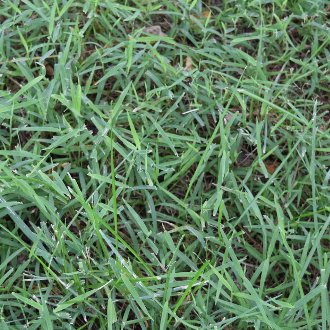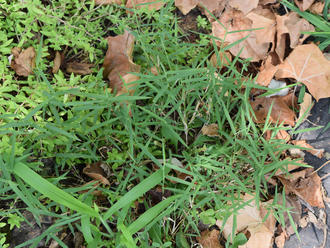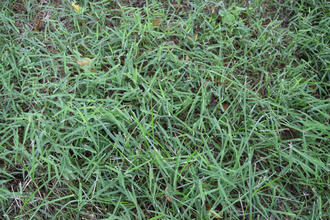Nimblewill (Muhlenbergia schreberi J.F. Gmel.)
↑Summary
A warm-season perennial grass native to North America with a sprawling, rhizomatous growth habit and narrow, blue-green blades; often found in lawns, particularly in wetter or shadier areas.
↑Range - Expand
| Legend | Color |
| Native | |
| Native or Not Present | |
| Introduced or Not Present | |
| Native or Introduced |
This tentative map is based on our own research. It may have limited data on Canada and/or Mexico, and there is some subjectivity in our assignment of plants as introduced vs. expanded. Read more in this blog post.
Although this plant occurs somewhere in each of these regions, it may only occur in a small part of some or all of them.
↑Habitat
Nimblewill is found in a variety of moist to mesic, partly sunny habitats, usually but not always on recently disturbed sites. Natural habitats include open woodlands, both in floodplains and bottomland forests where openings are due to flooding and/or poor drainage, mesic upland forests where openings are due to rock outcroppings and/or rocky or sandy soil, and forest edges.
It is most common in anthropogenic habitats and the intersection of natural and human-altered habitats, such as small forest fragments, woodland paths, power line clearances, fencerows, vacant lots or weedy margins in urban or industrial areas, and suburban lawns and gardens. It thrives in, and is often more abundant in degraded wild areas.
Nimblewill is largely indifferent to both soil texture and pH, and can occur on just about any soil textures including loam, sand, clay, gravelly soils, or thin soils over rock, and on acidic, neutral, and alkaline soils. It can survive in full sun but is most abundant in partial sun (2-6 hours of direct sunlight) but cannot survive in deep shade.
It often associates with whitegrass (Leersia virginica) towards the shadier end of its habitat preferences, but that species ranges into deeper shade. It also is often associated with the invasive species Japanese stiltgrass (Microstegium vimineum), which tends to grow taller than it and shade it out; although it can coexist with stiltgrass, stiltgrass suppresses its growth and numbers, and it benefits from stiltgrass removal.
Although this species favors moist to mesic habitats, it uses C4 metabolism and is thus more tolerant of prolonged dry spells than other species that grow in these habitats, often becoming temporarily more dominant in years with longer dry spells.
↑Life Cycle
Nimblewill is a sprawling, mat-forming perennial warm-season grass.
Seeds germinate in late spring to early summer; foliage from established plants usually emerges slightly earlier, in early spring. The bulk of growth occurs during the warm months, but some foliage on established plants emerges earlier than most warm-season grasses.
Stems initially grow upright, but do not support their own weight; as the plant grows taller, it will either lean against supporting vegetation, or sprawl along the ground, growing horizontally. Stems close to the ground often root at nodes. In this manner, this plant can reproduce vegetatively over short distances. Stems branch frequently, which on open sites can lead this plant to form a mat-like habit.
Plants usually reach a maximum height of about 18 inches, although stems may be much longer than this especially when they travel along the ground and root at nodes.
Plants bloom in early fall with seed maturing shortly thereafter. Foliage turns a pale straw color in winter and the plant goes dormant.
We could not find information on this species' typical lifespan.
↑Faunal Associations
The seeds are eaten by a number of birds, mostly small songbirds such as the American Tree Sparrow, Song Sparrow, and Slate-Colored Junco, but occasionally larger birds such as Mild Turkeys, but it is not a particularly important food source to any of these birds. Livestock will browse this grass and find it highly palatable. It is not usually browsed by deer or rabbits, in part because its foliage is only present during times of the year when other, more attractive foliage is abundant.
This grass is particularly good at supporting insects. The larvae of the moth Elachista brachyelytrifoliella mine the leaves of this and other members of this genus and also the Brachyelytrum genus. The short-winged meadow katydid (Conocephalus brevipennis) and the stink bug Hymenarcys nervosa both feed on this grass. The rusty plum aphid (Hysteroneura setariae) feeds on this and other grasses, and the ragweed root aphid (Prociphilus erigeronensis) feeds on the roots of this grass along with many other species, where it is cultivated by ant colonies. Several other aphids are known to feed generally on the Muhlenbergia genus and likely feed on this species as well. The leafhoppers Flexamia imputans and Plesiommata tripunctata also feed on this grass. The plant bug Stenodema vicinum feeds on this and other grasses, causing "silver top" damage. The plant also supports the larvae of gall flies (Astictoneura sp.) and the gall wasp (Eurytomocharis muhlenbergiae).
None of these species cause appreciable harm to this plant.
↑Control
This species is often unfairly demonized; it does not need to be controlled in its native range. In these areas it poses no ecological harm, and it can even enhance the robustness of a lawn and control erosion by surviving where other turfgrass struggles.
In the West where it is introduced, isolated plants not growing in a lawn can be controlled manually by pulling them out from the center, before they make seed. Follow-up is required for already-established populations, as it can persist in the seed bank for several years.
In arid regions, it usually will not thrive without irrigation, so xeriscaping with native plants and refraining from irrigating can often eliminate it and/or prevent it from establishing. It can also be replaced by its close relative native to the West, mat muhly (Muhlenbergia richardsonis). In the absence of irrigation, mat muhly will outcompete nimblewill.
The herbicide mesotrione (brand name Tenacity) has been used to control this plant when it is growing in with other turfgrass, but care must be taken with application because mesotrione is highly toxic to aquatic plants, and can also cause eye irritation in humans. Overuse of mesotrione has also led to resistance in agricultural weeds.
↑Uses
Nimblewill can be used as a turfgrass for lawns, where it is valued for its attractive blueish color and blade texture during summer months. It superficially resembles bermudagrass, but is a better choice as it is native. It is more popular for this purpose in the south of its range, where cool-season turfgrasses that stay green through the winter often fare poorly. It dies down in fall, leading to a pale straw color in winter months. It is more tolerant of shade than most other turfgrasses, and also has above-average tolerance of rocky, clayey, and sandy soils. As a turfgrass it is unusually good at supporting birds.
↑Related Plants
Numerous other Muhlenbergia species, often called Muhly grasses, overlap with various parts of this species' range. With the exception of Muhlenbergia diversiglumis, which is native to Mexico but has been introduced on one site in Texas, all of these other species are native.
A 2021 biogeographical analysis by Peterson et. al. placed this species as probably closest-related to four species native to east Asia, none of which occur in North America. Among native species it was placed as closest-related to a group of species, all of which are closer-related to each other than to this species; this group is made up of rock muhly (Muhlenbergia sobolifera), inland muhly (Muhlenbergia glabrifloris), Mexican muhly (Muhlenbergia mexicana), slimflower muhly (Muhlenbergia tenuiflora), wirestem muhly (Muhlenbergia frondosa), nodding muhly (Muhlenbergia bushii), California muhly (Muhlenbergia californica), and woodland muhly (Muhlenbergia sylvatica).
↑Notes
Nimblewill is amphistomatous, meaning it has stomata on both top and bottom surfaces of its leaves. This quality is relatively uncommon in general and is mostly limited to fast-growing annuals or slow-growing trees or shrubs, and is particularly rare in perennial grasses. It is also atypical among the Muhlenbergia genus.
It is not know why this species is amphistomatous, but given that this species has relatively thin leaves, it probably increases gas exchange capacity between leaves and air, and may also reduce temperature gradients and thus reduce condensation on leaves. Another simple explanation may be because it can: because it uses C4 metabolism and usually occurs in moist habitats, it tends to have abundant water, and increased water loss is the primary downside to amphistomy, so even if the benefits are only slight, they may outweigh the costs being negligible.
↑Links & External Resources
• Muhlenbergia schreberi (Nimblewill) | Illinois Wildflowers (About This Site)
• Muhlenbergia schreberi (Nimblewill) | USDA PLANTS Database (About This Site)
• Muhlenbergia schreberi | Go Botany (About This Site)
• Nimblewill | iNaturalist (About This Site)
• Muhlenbergia schreberi | Biota of North America Project (BONAP) (About This Site)
• Muhlenbergia schreberi | NatureServe Explorer (About This Site)
• Muhlenbergia schreberi | Flora of North America (About This Site)
• Nimblewill | Maryland Biodiversity Project (About This Site)
• Muhlenbergia schreberi J.F. Gmel. (Nimblewill) | Digital Atlas of the Virginia Flora (About This Site)





